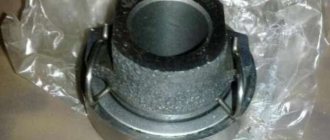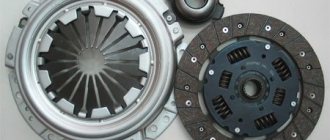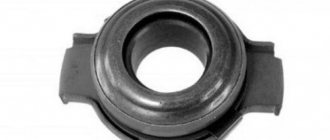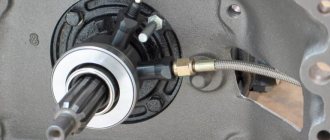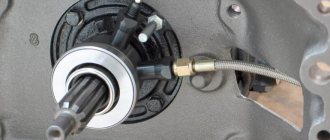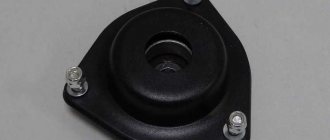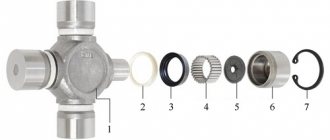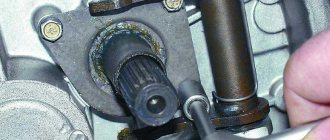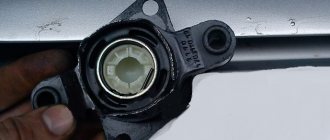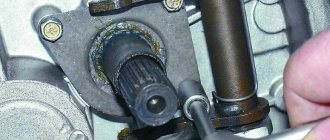Device
Modern car mechanisms use 2 types of bearings: roller and hydraulic ball. The first one is conventional, it is a mechanical device that transmits force due to a rigid traction connection. Hydraulic operates through the force created by the hydraulic system, which does not require pedal pressure. The function of the clutch is to smoothly disengage the transmission from the engine when changing gear. I cannot decide for myself which of the two mechanisms is better. They both have a long service life if used carefully and correctly.
The structure of this mechanism is as follows: by means of pressure, the pressure plate presses the driven disk against the flywheel. The flywheel hub is connected to the input shaft and moves along it. Damper springs located inside the shaft reduce vibrations. Thanks to this, the inclusion is smooth. And in order to create the required force, the diaphragm spring acts on the pressure plate. The inner diameter of the spring, made in the form of metal petals, is influenced by the clutch release bearing. It is located on the axis of rotation. It is entrusted with the functions of a transmission device between the clutch and the drive.
I often come across the misconception that rotation of the release bearing occurs exclusively when the car is moving. But in reality, when the clutch is depressed, torque is supplied to the cage. If you hold the clutch for a long time while the gear is engaged, an uneven load is placed on the bearing. For this reason, parts wear out quickly. After all, when the vehicle is moving, it remains at rest and begins to work when gears are changed. Any breakdown makes it impossible to continue driving the vehicle.
Operating principle
The release bearing's job is to connect and disengage the clutch when you press the pedal inside the car. The operating principle of the part is quite simple:
- the driven disk is pressed against the flywheel by a pressure disk, due to which clutch is ensured;
- the pressure on the pressure plate is provided by a diaphragm spring, the inner petals of which are acted upon by the clutch release bearing;
- the movement of the bearing, which initiates the separation of the discs, is ensured by the clutch fork.
Release bearing in a car clutch system
How does a clutch release bearing work - the mechanics of the process
In short, this element ensures that the disk is disengaged from the basket. In addition, its functions include disengaging and engaging the clutch. There are two types of such bearings: roller, which operates due to a rigid connection between rods, and hydraulic, which creates force using a hydraulic system.
The clutch is necessary in order to smoothly disconnect the engine from the transmission during gear shifts, this helps protect transmission elements from unnecessary overloads, as well as dampen vibrations. The operating diagram of this mechanism is as follows. A pressure plate connected to the housing presses the driven disk against the flywheel. Its hub is connected to the input shaft and can move along it. Inside the hub there are damper springs that dampen torsional vibrations and ensure smooth operation.
Purpose
To understand where the release bearing is located, you need to understand the purpose and design of the clutch. The clutch and all its parts belong to the vehicle's transmission. It ensures the transmission of torque from the engine to the drive axle and wheels, and must be located between these parts of the machine
But an important condition for the location is accessibility in its control by the driver. Most often this is the clutch pedal, less often the lever near the steering wheel
Using the clutch mechanism, the driver periodically disconnects the engine from the transmission. This allows you to stop the car, change the gearbox, and change the driving dynamics.
Proper bearing performance check
In most car models, manufacturers install release bearings with a high degree of reliability. Thanks to this, during operation, their resource is distributed over a long mileage, because it comes into operation only when the clutch pedal is pressed.
The part is subjected to significant loads during a sharp start, slipping of the drive wheels, and long journeys, for example, on a highway with poor-quality surfaces.
The driver must notice a problem with the release bearing in time in order to carry out preventive work on the clutch in a timely manner. There are no special diagnostic tools provided to determine its performance. Failure can be determined by indirect signs, which differ for mechanical and hydraulic structures.
Obvious symptoms include the following:
- During operation of the gearbox, extraneous noises are heard;
- it is not possible to change speeds freely;
- the clutch slips.
First of all, the clearance of the fork and the working cylinder rod is controlled. Then we find out the condition and performance of the release bearing. We will need to start the engine, depress the clutch, and then analyze the noise. Obvious knocking or whistling sounds that appear while pressing and disappear after returning the pedal to the upper position indicate a bearing failure.
The physical condition of the part can be determined after dismantling the box. You will need to remove it simultaneously with the input shaft guide and the clutch.
During visual diagnostics, we determine permissible backlash, jamming, and damage to the housing. The problem may occur after the lubricant has run out. In this case, we remove the contaminants and fill the assembly with lithol or other suitable lubricant, and then return everything to its place. It is necessary to check the smooth running and quality of rotation. After complete assembly, we check the functionality with the engine turned on.
Often found on a hydraulic structure is such an indirect sign as pedal failure. This is a consequence of the lack of tightness of the drive and the piston on the bearing. Before dismantling the box, the driver is required to check the condition of the working and master cylinders of the drive, and the entire hydraulic wiring of the unit is also monitored. You will need to look into the tank to check the fluid level and also make sure there are no air pockets.
Causes of bearing failure
The operation of the squeezing device is subject to constant dynamic loads. Engine power depends on speed, because of this the impact on the part is not constant.
Worth remembering:
Torque exerts load only when the pedal is pressed. Based on this, we highlight the most common symptoms of a faulty release bearing, described below.
- Holding the clutch in the disengaged state for a long time. Uneven transmission of force leads to increased wear of the part.
- Sharp throws and pedal presses. This style is typical for lovers of aggressive driving. Great force is immediately applied to the part, which can cause breakage.
- Incorrect setting of the cable stroke or rod of the working cylinder. The nickel ends up in constant contact with the forks.
All causes of malfunctions come down to the human factor. Improper handling of the pedal results in sudden loads on the part. There are frequent cases of complete destruction of the VP.
Types of release bearings
Nowadays, two types of release bearings are common: * roller or ball - mechanical units that transmit force to the bearing through a rigid bunch of rods; * hydraulic - here the force is created by hydraulics, due to which the clutch pedal is depressed much easier.
The mechanical clutch release bearing can be called a part from the past, because Moskvich, VAZ and other old cars were equipped with it. New machines, even budget ones, mainly use hydraulic systems. Although a number of domestic cars currently produced are still equipped with mechanics, in order to reduce the cost and simplify them.
Let's look at several reasons for replacing this part.
The dual mass flywheel (ZMS) becomes faulty as a result of overheating, which can occur as a result of improper operation of the vehicle. For example, as a result of slipping, the mechanism overheats and the lubricant dries out, which is why the flywheel has to work with high friction. The consequence of this is jerking during gear changes. During a visual inspection, this problem can be identified by a change in the color of the metal or the appearance of cracks on it.
Sachs dual mass flywheel
The primary flywheel is worn out. This occurs due to gear overloads, which can cause internal parts to be destroyed and the ZMS to fail. If upon inspection you notice seeping lubricant, then this is the problem.
The internal parts of the secondary flywheel are worn out. The root cause of this is the failure of the release bearing located between the primary and secondary flywheel. There is a general heating of the mechanism, which reduces the effect of the lubricant and causes the parts to run dry.
ZMS has been blocked. If the flywheel is faulty, it means that too long mounting bolts were used during installation. This causes both the primary and secondary flywheels to lock, resulting in loss of shock absorption, grinding noise, and noise when pressed.
Clutch cylinder malfunction. This problem is not considered serious. The most common malfunctions are: fluid leakage and air ingress.
How is the clutch release bearing replaced?
The clutch release bearing is replaced as follows. First, the gearbox is removed, then it is necessary to disengage the ends of the spring clamp from engagement with the clutch, and the bearing itself is removed from the guide sleeve. Next, you need to wring out the spring holder's legs and remove it. Now you can remove the bearing from the coupling on which it is located.
Be sure to check it thoroughly before installing a new part. The new bearing should rotate very easily, no jamming or play is allowed.
When installing a new part on the coupling, make sure that the protruding part of its inner ring faces to the side. Secure it in this position using the holder. The guide bushing is lubricated with grease, then a bearing is installed on it. The clutch together with it is fixed with a spring clamp, and the final step is to install the gearbox in place.
The clutch assembly can be considered the most important device in a car. Thanks to the clutch, there is a safe, smooth disconnection and connection of torque from the engine to the gearbox. In the clutch system of manual transmissions, one of the main roles is played by the release bearing (BM), which will be discussed in this article.
Possible malfunctions, their symptoms and diagnostics
No special equipment is required for diagnosis. The symptoms are eloquent and difficult to confuse with other elements. It is enough to listen to the car yourself while pressing the pedal.
Signs of a faulty release bearing:
- whistling, crunching, localized in the pedal area;
- characteristic knocking sound of the drive when the engine is running;
- shocks when pressed, pedal wedge;
- Difficult gear shifting, sometimes accompanied by extraneous sounds.
How to check the release bearing:
- start the engine, put the gear in neutral;
- press the clutch, listen to extraneous noises;
- engage the gear and slowly release the pedal.
The occurrence of at least one of the described symptoms indicates the need to replace the bearing. Delaying the procedure threatens its complete destruction.
How to check the clutch release on a car:
Signs of a faulty release bearing:
When diagnosing, remember the features of VP:
The sound of a pressed pedal does not always indicate a malfunction. This is normal in cold weather. Rollers (balls) are made of steel that does not have large linear expansion. The holder is cast from heat-treated metal. This difference can cause a gap to appear that is acceptable for operation.
How to replace a release bearing
Operations for replacing different types of squeezing devices have similar technological steps. Let's look at mechanical and hydraulic structures using specific examples.
Mechanical clutch type. Step-by-step instruction.
For clarity, let’s take a VAZ 2114 car. Before starting disassembly, ensure sufficient lighting of the gearbox. Prepare your workplace and tools.
Advice:
It is recommended to perform the gearbox removal operation in a pit. This ensures full access to the checkpoint. The help of a partner will not be superfluous.
Photo report of gearbox removal:
After removing the transmission from the vehicle, you can proceed to replacing the spare part:
- Carefully inspect the inside of the bell. Make sure the fork fastening is intact. If there are signs of damage, replace it.
- Locate the edge of the spring that secures the clutch. Use a screwdriver to pry off the bearing.
- Clean the shaft splines of old grease and dirt.
- Let's start replacing the part. Lubricate the seating surfaces and gearbox shaft. Use CV joint lubricant.
- We put the new part on the shaft. Install the retaining spring.
- Check the axial travel of the coupling. It should be free of jams.
- We check the rotation of the rollers (balls). There should be no rolls, wedging or other defects in the process.
This completes the replacement. The gearbox can be installed in reverse order.
Advice:
Be sure to check the condition of the driving and driven clutch discs and basket.
Photo report of VP replacement
Hydraulic clutch type. Step-by-step instruction.
As an example, consider a Ford Focus 2. The preparatory stage consists of removing the gearbox from the engine.
Advice:
The box mounting bolts vary in length. Be sure to label them before unscrewing.
Photo report of gearbox removal:
Replacement of the release bearing is carried out according to the following plan:
- We inspect the inside of the protective casing. We remove oil, dirt, and wear products from friction linings and clean the space.
- Unscrew the bolts securing the spare part housing. Remove the element from the gearbox shaft.
- We clean the seating surface from traces of oil and dirt.
- We install the new part on the shaft. Tighten the bolts of the fluid coupling housing.
- We check that the pipe-to-fitting adapter is installed correctly.
- We install the transmission on the car according to the instructions.
Upon completion, it is necessary to bleed the hydraulic drive system to remove air. It is recommended to carry out the operation with a partner. After each deep pedal press, unscrew the outlet fitting and release the air. Repeat the procedure several times.
Advice:
Carefully inspect the fluid inside the clutch reservoir. It should not be cloudy or dirty. Otherwise, remove it with a syringe, fill in a new one and bleed the system.
Photo report of VP replacement
How does a clutch release bearing work?
There are two types of release bearings - mechanical and hydraulic. The first, as is clear from the name, is driven by mechanical action thanks to special rods and cables. The hydraulic type works under the guidance of hydraulics, which takes on the power loads, making it easier for the driver to use this unit.
The release bearing device is quite simple at first glance, and at the same time it is very effective. The VM consists of a bearing, as you might have guessed from the name, and a coupling on which it is pressed. The clutch release bearing is located on the gearbox input shaft, or rather on its flange. Depending on the clutch pedal, the bearing moves along this shaft.
It works as follows. When you press the clutch pedal using rods or cables, or hydraulics in the case of hydraulic systems, the pressing force is transmitted to the clutch fork. This fork actually moves the release bearing along the flange. The release bearing, in turn, acts on the clutch basket petals, resulting in the separation of the friction discs. It is at this moment that one gear or another is switched.
When the previously depressed pedal is released, the CM returns to its original position, as well as the petals of the diaphragm spring. There is no pressure applied, so the flywheel, pusher and driven are connected, resulting in the clutch being engaged.
Prevention of bearing failure. How to increase service life
Proper operation of the clutch pedal will not only preserve the release unit, but will also extend the service life of the entire device.
- Tip 1 : Do not practice unnecessary sudden starts of the car from a standstill. At this moment, huge dynamic loads arise, contributing to bearing failure.
- Tip 2 : No need to keep the clutch disengaged in traffic jams or at traffic lights. Place the car in neutral and release the pedal.
- Tip 3 : Don't "throw" the clutch. For this reason, not only the bearings wear out, but also the disc. Excessive force only increases the negative effect of torque.
- Tip 4 : Avoid situations where the car slips. To turn the wheels, enormous force is required, which is transmitted through the entire drive mechanism.
- Tip 5 : When replacing a bearing, rely on the choice of trusted manufacturers. A table with recommended companies is presented below.
Why does a release bearing fail?
VM failure occurs for several reasons. Firstly , due to the fact that some drivers abuse the clutch and, squeezing it for a long time, do not release the pedal (keep their foot on the pedal), thereby subjecting the release bearing to heavy loads. This small part is not designed for long-term loads, since the task is to quickly change gears while receiving a minimum load. But if the clutch is depressed for a long time and this happens regularly, the service life of the part is significantly reduced.
How to extend the resource?
To increase the service life of the device, you must drive on smooth roads. In our country, it is problematic to comply with this condition. Keep in mind that uneven roads destroy not only the vehicle’s chassis, but also the clutch system. Therefore, regular off-road driving is also dangerous for bearings. Don't make mistakes when operating your car. When the car is stopped at a traffic light, there is no need to depress the clutch pedal and engage first gear if you do not plan to move. This should only be done at the beginning of movement, since the part operates under high load conditions. Regular lubrication will increase the service life of the device.
Replacing the release bearing
Replacing the release bearing yourself is quite possible, provided that “your hands are in the right position” and you have everything you need for the job. The work is carried out in the following sequence: drain the oil, unscrew the bolts connecting the gearbox and the engine, then dismantle the box (although there is a way to replace the clutch without removing the box and draining the oil) and disconnect the bearing from the fork. Afterwards, the VM itself is removed, and a new one is installed in its place. After completing all the work, you need to adjust the clutch, you can learn how to do this from this article.
Repair and replacement of the clutch slave cylinder
When choosing a spare part to replace the clutch cylinder, you should pay attention to the material from which the part body is made. As noted earlier, such material can be cast iron, steel, aluminum or polymers
Today, many manufacturers offer aluminum and even polymer cylinders, but such parts are less reliable.
There are several types of clutch cylinder malfunctions that will require rod repair:
- leakage of working fluid through worn seals or connecting tubes with defects;
- presence of cracks in the cylinder body;
- broken working cylinder springs.
The rod consists of several components, each of which is subject to wear. Its parts - pusher, piston, cuffs, spring - experience high loads during operation, so there is a possibility that they may fail.
Symptoms of a faulty clutch cylinder:
- a decrease in the level of brake fluid in the cylinder reservoir and the appearance of spots under the car while parked;
- the pedal fails and the clutch works intermittently;
- There are problems with shifting gears.
Experts advise, first of all, to pay attention to the travel of the clutch pedal. If it runs too softly, this is not yet a reason for urgent repairs, but the operation of the cylinder should be diagnosed.
To check it, you need to bleed the clutch hydraulic drive. If there are air bubbles in the working fluid, you should understand the reasons for their appearance. As a rule, air gets inside the rods of the clutch slave and master cylinders due to depressurization of the sealing collars.
As noted earlier, repairing and replacing the clutch slave cylinder is not a very difficult task. This part is most often located on the gearbox housing.
First you need to unscrew the fastening bolts, disconnect the pusher from the fork and begin dismantling the hose that comes from the main circulation center.
Since there is working fluid in the master cylinder, the hose should be plugged (for this you can use a plug of the appropriate diameter). There is also another opinion - you need to disconnect the hose to completely drain the brake fluid (it is believed that this will help flush the clutch hydraulic system from dirt).
After dismantling, the clutch master cylinder must be disassembled and, if possible, repaired. If this part has a metal body, then it can be fixed in a vice, but if the part is plastic, then you need to be careful not to damage it.
After disconnecting the air valve, it is necessary to remove the outer cuff. After this, taking into account the design features of the cylinder, it is necessary to provide access to the rod and remove the retaining ring. After disassembling the part, you must ensure that there is no damage to the spring, rod or defects of the cylinder mirror.
All components must be washed with brake fluid. We noted earlier that kerosene, gasoline, motor oil or water cannot be used for this purpose (these liquids contribute to the swelling of rubber elements).
When assembling the cylinder, all seals and seals should be replaced with new ones.
Repair of the clutch master cylinder will not be possible if:
- body cracks;
- noticeable wear on the inner surface of the body, which appears as a result of defects in the rod.
In this case, you need to completely replace the faulty clutch cylinder with a new part.
After replacing the clutch master cylinder, do not forget to bleed the system.
The method for bleeding the hydraulic drive system after replacing the clutch slave cylinder does not differ from that described previously for the hydraulic clutch. At the same time, in some car arches (for example, on Fiats), the clutch system is back-pumped. To do this procedure yourself you need to prepare:
- a hose that fits tightly onto the exhaust valve;
- a large syringe, the diameter of the nozzle of which corresponds to the size of the hose;
- a wrench to remove the air release valve.
First, unscrew the cap of the reservoir with the working fluid and draw it into the syringe. You need to expel all the air balls from the syringe, and then connect its spout with a hose, the second end of which is connected to the release valve. After this, you need to unscrew the valve 2-3 turns, press the syringe and pump the brake fluid into the clutch cylinder. To prevent air from entering the system, you must first tighten the valve and only then remove the hose.
This sequence of actions must be performed several times until all the air is forced out of the hydraulic drive system into the tank. After this, you need to depress the clutch pedal about 10 times and, if necessary, adjust its travel height.
How to get to the service station if the bearing is stuck?
In the event of a bearing failure, movement can be continued in several ways, this, of course, with the help of a tug and without a clutch, that is, without squeezing the pedals.
To get to the service station yourself, do the following:
- Turn on first speed.
- Start the starter.
- After starting to move, release the gas and move the gearshift lever to the 2nd speed position.
- Accelerate and shift to 3rd gear. At the same time, catch the moment when the speeds of the engine and shaft are approximately at the same level.
Remember that using this method is not recommended due to the risk of “ruining” the clutch basket and possibly even the gearbox. As soon as you manage to get to the service station, ask to change the bearing and, if necessary, it’s worth changing the clutch at the same time. If you don’t have extra money, you can do the work of installing a new part yourself. A brief algorithm of actions is given below.
Clutch cable adjustment
The cable should be adjusted using a special nut, which allows you to adjust the cable mark. This procedure should be taken seriously, because incorrect adjustment can lead to either loosening of the cable or excessive tension.
The main reason for cable rupture is corrosion. As a result of the rupture, the clutch stops working.
Biting or, in other words, tearing of the cable is another reason why the clutch may stop working. If the metal threads of the cable begin to stop the movement, resting against the braid, then driving the car becomes much more difficult. The pedals may not be pressed well or may not return to their original position.
You can clearly see how to adjust the cable in the video:
Signs
The main signs of an impending breakdown are its slipping and incomplete shutdown.
Clutch system
During incomplete shutdown (the pedal is depressed), it is difficult to change gears with the engine on. The appearance of noises and crackles when shifting gears, increased free play of the pedal. When the clutch slips when the pedal is released, a burning smell is felt, the vehicle's movement is deteriorated, the engine overheats, and fuel consumption increases.
If you notice such signs of a malfunction, if you cannot fix the problem yourself, immediately go to the nearest service station. If you get there on your own, then move slowly, don’t accelerate too much and be very careful when changing gears. It would be a good idea to use a double squeeze when switching.
Clutch pedal
You can also resort to a special technique. When shifting to a higher gear, the clutch must be depressed and the gear lever must be held in neutral for a while. Next you need to release, then squeeze again, then turn on the gear you need.
When switching to a lower gear, the gear lever, as in the previous case, must be held in neutral. Next, we release the clutch and lightly press the gas, then squeeze it again and go to the required gear. If you can master this kind of gear shifting, you will significantly reduce the load on the clutch and extend the life of the gearbox.
